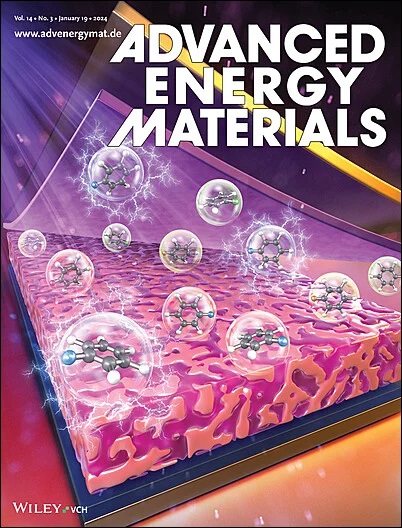Proton Donation and Surface Armor Effects of Aluminum Ion Additive Enabling Long‐Life and High‐Voltage Aqueous Proton Batteries
IF 24.4
1区 材料科学
Q1 CHEMISTRY, PHYSICAL
引用次数: 0
Abstract
Aqueous proton batteries (APBs) have been regarded as promising candidates for large‐scale energy storage owing to their environmental friendliness and intrinsic safety. However, the commonly‐used strong acid electrolytes in APBs often lead to dissolution and corrosion of the electrodes. To address these challenges, a new mildly acidic CH铝离子添加剂对长寿命高压水溶液质子电池的质子捐赠和表面装甲效应
水溶液质子电池(apb)由于其环境友好性和内在安全性而被认为是大规模储能的有希望的候选者。然而,在apb中常用的强酸电解质经常导致电极的溶解和腐蚀。为了解决这些问题,提出了一种添加Al2(SO4)3的新型温和酸性CH3COONa电解质,用于稳定的apb。apb中的Al3 +添加剂起到了质子供体的双重作用,既可以持续维持工作电极的质子供应,又可以在阴极表面形成阴极电解质界面(CEI),防止电活性材料的溶解和结构崩溃。Co-Ni双氢氧化物(CoNiDH)材料在混合电解质中表现出质子主导的电荷存储机制,具有230 mAh g−1的高放电容量和优异的倍率性能。此外,混合电解质组装的APB具有2.2 V的高电池电压,94.7 Wh kg−1的能量密度,以及超过8500次的长循环寿命,优于大多数报道的APB。这种温和的电解质设计有望拓宽适用于apb的电极材料的范围,为高性能水性电池的发展提供新的机会。
本文章由计算机程序翻译,如有差异,请以英文原文为准。
求助全文
约1分钟内获得全文
求助全文
来源期刊

Advanced Energy Materials
CHEMISTRY, PHYSICAL-ENERGY & FUELS
CiteScore
41.90
自引率
4.00%
发文量
889
审稿时长
1.4 months
期刊介绍:
Established in 2011, Advanced Energy Materials is an international, interdisciplinary, English-language journal that focuses on materials used in energy harvesting, conversion, and storage. It is regarded as a top-quality journal alongside Advanced Materials, Advanced Functional Materials, and Small.
With a 2022 Impact Factor of 27.8, Advanced Energy Materials is considered a prime source for the best energy-related research. The journal covers a wide range of topics in energy-related research, including organic and inorganic photovoltaics, batteries and supercapacitors, fuel cells, hydrogen generation and storage, thermoelectrics, water splitting and photocatalysis, solar fuels and thermosolar power, magnetocalorics, and piezoelectronics.
The readership of Advanced Energy Materials includes materials scientists, chemists, physicists, and engineers in both academia and industry. The journal is indexed in various databases and collections, such as Advanced Technologies & Aerospace Database, FIZ Karlsruhe, INSPEC (IET), Science Citation Index Expanded, Technology Collection, and Web of Science, among others.
 求助内容:
求助内容: 应助结果提醒方式:
应助结果提醒方式:


